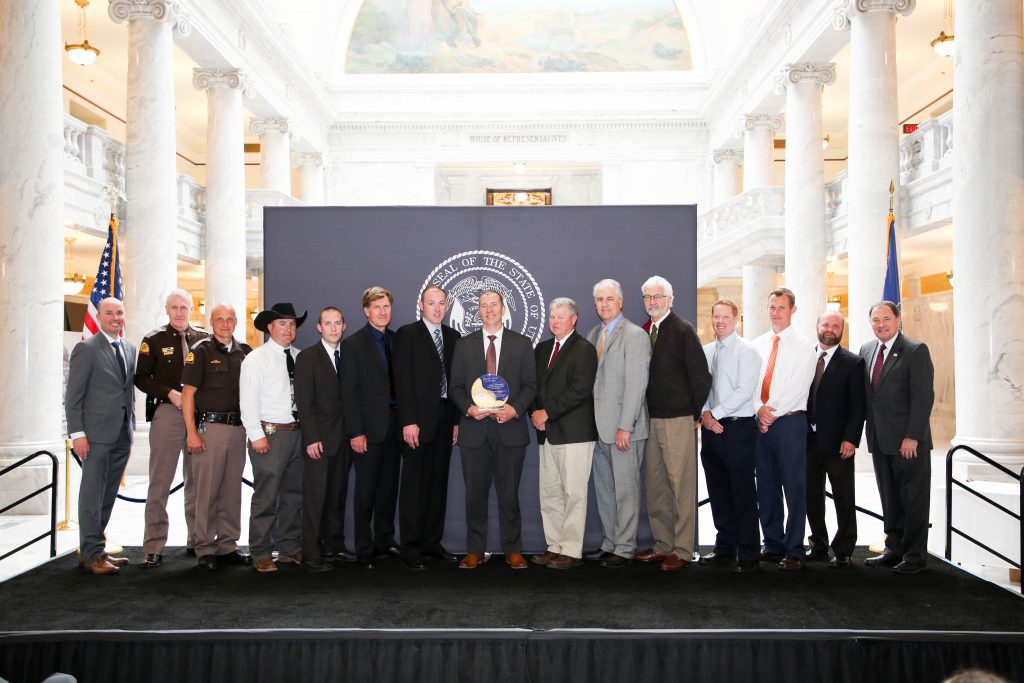Some information may be outdated.
A helicopter hovered over an RV at a rest area on U.S. Highway 191 in northern San Juan County, its search light and rhythmic whirring drawing the attention of people in the area overnight. On a different night, a helicopter hovered over four women hiking in the Box-Death Hollow Wilderness area in Escalante. In a separate incident, four people running near Interstate 70 in Grand County looked up to see a helicopter overhead as they tried to escape law enforcement.
The scenes are examples from some of the recent places the Utah Department of Public Safety has been called to this year. The agency has seen over 150 calls so far this year.
Kyle Curtis lives in Moab and said he’s familiar with the calls — he responded to some of them as a tactical flight officer and a rescue specialist with the Utah Department of Public Safety Aero Bureau. As a Utah Highway Patrol sergeant, he’s on the road working in Moab when he’s not responding to calls for help.
From the desert to the mountains, he said calls for help requiring aerial operations have increased across Utah this year, and Gov. Gary Herbert recently recognized the Aero Bureau for its continued excellence in public safety.
Gov. Herbert commended Curtis and the team behind the Aero Bureau with the Governor’s Award for Excellence for Outstanding Public Service in Salt Lake City. Curtis said it’s probably the first time the team has won an award for its work.
Utah Highway Patrol Colonel Michael Rapich told the Aero Bureau team in announcing the award that its efforts across the state are critical to public safety operations.
“Your actions have repeatedly saved lives and resources across the state,” Rapich said.
In 2018, the team helped rescue 122 people on 113 search and rescue missions in Utah, with 32 of the flight operations in hazardous and high-risk situations.
The Utah Department of Public Safety (DPS) Aero Bureau responds to a little bit of everything in Utah: search and rescue calls, law enforcement support and apprehension, wildlife calls, communications and avalanche operations.
The people running near Interstate 70 had fled on foot to allude a Trooper who stopped to see if they needed help with their vehicle broken down on the side of the roadway.
“These four people just book it across the freeway and out into the desert,” he said. “He calls me and then the ball gets rolling and we get a lot of resources out there and we’re trying to capture these four people … but they wouldn’t come in, they wouldn’t surrender.”
The officers learned the four people were runaway teenagers and had left Colorado in a stolen vehicle. Two of the teens eventually surrendered, but Curtis said after an hour-and-a-half, he assembled a team with a Grand County deputy sheriff to follow the other two teens in the helicopter. Curtis and two officers were able to safely take the two other runaway teens into custody after a short pursuit.
As for the call to the highway rest area near Hole in the Rock, the DPS helicopter was used to provide support during an investigation into a person who had died alone in an RV.
“That was basically a support mission for — a timely manner — bringing down the State Bureau of Investigation’s team so that they could do a scan of the trailer, investigate and make sure it wasn’t anything more than just an unattended death.”
Transporting the team to San Juan County by helicopter took about 1 hour compared to what would have been a 4-hour drive.
To respond from Moab to the remote rescue call in Escalante, he drove to Interstate 70 and waited in Green River for the Utah Department of Public Safety helicopter to pick him up.
The women were hiking along a stream in a slot canyon, but until the challenge of the wilderness forced them to push their emergency beacon. A local search and rescue crew there assessed the women’s situation and couldn’t reach them at nightfall.
“They ended up getting in deeper water than they anticipated, and so water up to their neck versus just their knee,” Curtis said. “They got wet, got ledged-out, got tired and then got really cold. And so they’re stuck on a ledge, fighting hypothermia that way, and then they set off their spot tracker.”
With a hoist and the pilot using night-vision goggles, Curtis rappelled into the canyon and helped each woman one at a time with a vest-style harness.
“Luckily they were safe, pretty much uninjured, just exhausted and cold and who knows how they would have fared through the night on that one,” Curtis said.
He said the group of women had prepared for their hike, but it didn’t go as planned.
“Sometimes you can’t prevent bad things from happening — a twisted ankle or a broken leg — but being prepared and knowing how to get resources to you and getting them there early before it becomes a life and death situation is always better than to wait until there’s no more hope,” Curtis said.
Emergency beacons save time and resources in Utah’s remote wilderness.
“But if you don’t have the opportunity to have one of those, or rent one of those from somebody, make sure people know where you’re at,” Curtis said. “Leave a good detailed plan of where you’re at, when you’re going in, when you’re coming out.”
Utah Department of Public Safety sees increase in aerial operations
“Your actions have repeatedly saved lives and resources across the state.”
Appreciate the coverage? Help keep local news alive.
Chip in to support the Moab Sun News.





